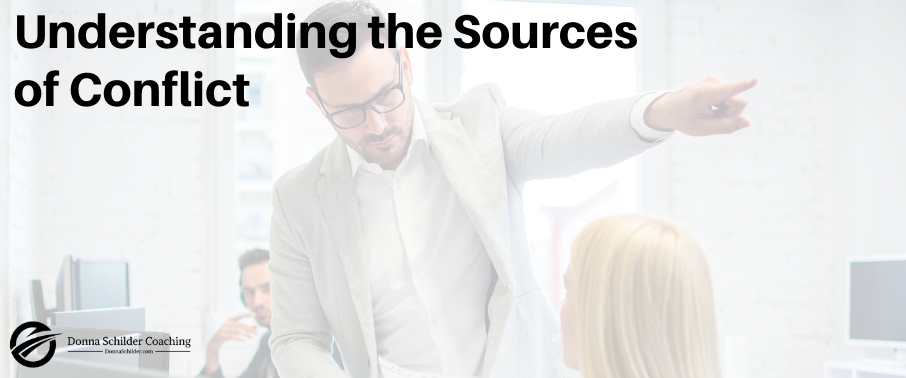Understanding the 4 Types of Conflict Will Strengthen Your Leadership Skills
Understanding sources of conflict is a valuable Leadership skill.
When I was on the Executive Leadership Team of a large Medical Group years ago, I experienced a great deal of conflict.
When I first joined the team, I wasn’t as effective as I’d like to be in managing this conflict; so I sought out tools and techniques to improve my conflict management skills. I learned about the 4 Sources of Conflict and how to approach them and became much more skilled at resolving conflict.
The 4 Main Types of Conflict
The four main sources of conflict are:
- Goals
- Methods
- Facts
- Values
Knowing how to approach each of these types of conflict will make resolving conflict much easier.
As I reviewed the conflicts I got into, I realized that I got into Methods conflicts the most often (probably because I was a Process Improvement Expert). I found that once I knew I was in a Methods conflict it was easy to resolve it. The important wasn’t how something got done, it was that it got done.
For example, if we were talking about “how” to collect wait time data, I could let the front line people who were going to collect come up with how to collect it. Then, if I felt that their method wouldn’t work or wasn’t as efficient as it could be, I could:
- Let them do it their way and check to see if they ran into problems
- Or gently share my alternative way of doing it
As another example, if I was giving my assistant a flowchart to document in Visio, I could let her do it her way because the result was the same whether she did it my way or not. (My poor assistant, I was very controlling before learning this conflict model. I had squelched her empowerment!)
1. Goals Conflict
The most common type of conflict is a Goals conflict.
As an example, I have a goal of giving the customer a product that fully meets their needs and you have the goal of reducing the cost of the product so that the profit margin is larger. These two goals can be at odds.
To Resolve a Goals Conflict You Can:
- Find the common over-arching goal and let it guide a decision in one direction or a compromise (Say, in this case, it is selling the product)
- Determine how to prioritize the conflicting goals to meet the over-arching goal (in this case, to meet the over-arching goal of selling the product, my goal of meeting customer needs would be the first priority)
Often the best approach to a Goals conflict is a compromise. In our example, we can work together to keep the costs of the product down as much as possible, while ensuring all the features that the customer wants are included.
But, if the other person’s goals are completely at odds with yours, you may not be able to compromise and one or both parties must accept the consequences of meeting one party’s goals.
For example, if Joe wants to go over budget to purchase 2 new pieces of equipment that will make his production process faster and I, as the CEO, don’t want Joe to go over budget because our sales are down, I can compromise or I can choose to meet my goal and not Joe’s goal:
- I can compromise by letting Joe go over budget half as much and purchase 1 piece of equipment
- I can say “no” and accept the consequences of Joe not being able to purchase the new equipment (his goal) he wants to purchase (slower production)
2. Methods Conflict
The next type of conflict is a Methods conflict. This conflict is about “how” something is done (the approach, the process, the tools used, etc.)
Once you know a conflict is a Methods conflict, it often becomes rather easy to resolve the conflict.
To Resolve a Goals Conflict You Can:
As I stated earlier, once you know a conflict is a Methods conflict, it often becomes rather easy to resolve the conflict.
Firstly, you should realize that the end result is more important than how the task is accomplished (the method). Once you understand this, the emotion you have tied up in the method should dissipate, making it easier to collaborate.
One of the best ways to resolve a Methods conflict is to let the other party choose the method, as long as the outcome is achieved.
This was a great lesson in empowerment for me as a leader. As a new leader, as is often the case with new leaders, I thought my way of doing things was always the best way. This led me to conflict with my team members who were the people actually doing the work.
As a seasoned leader, I had learned that my team was more energized and effective when I gave them ideas on how to get their work done but left it up to them to determine how to get it done. And, they were the ones who really knew best about how to get the work done and which method worked best for them.
Sometimes we had to course correct their method, but most of the time, their method worked and they felt empowered by being able to do their work, their way.
Other Ways to Resolve Methods Conflicts
If you truly can’t let the other party choose the method for accomplishing the task, you can:
- Test each method and choose what works best
- Blend the methods together
- Find an alternative method
3. Facts Conflict
A Fact conflict centers on whether the information or data presented is correct.
To Resolve a Goals Conflict You Can:
- Review the facts
- Verify the facts
- Gather additional data
Once you understand you are in a Facts Conflict, your job is to help the other person see that the facts you’ve presented are correct or find out that your facts are not correct. And, once the accuracy is determined, both parties can accept the veracity of the data and move on.
4. Values Conflict
A Values conflict is the most difficult type of conflict to resolve because values are at the core of who we are.
To Resolve a Goals Conflict You Can:
- Seek to understand the other person’s values
- Clarify your values
- Seek compromise
- Know when to quit (agree to disagree)
You are often better off respecting the other person’s values than trying to change their values (which is nearly impossible).
But in some cases, a behavior change can resolve a Values conflict. For example:
- We can decide not to discuss politics or religion
- We can agree to disagree on and continue to move forward
- One party can agree to support the other party’s value in the specific situation (e.g., you can agree to support my value of not being exposed to, or using profanity, by not using profanity in my presence)
This framework for understanding sources of conflict has been invaluable to me over the years, helping me to quickly understand many conflicts I encounter, giving me a road map of how to approach each conflict, and increasing my success in resolving conflicts. Knowing that the main sources of conflict are Goals, Methods, Facts, and Values can make it quick and easy to understand the landscape of a conflict and to determine the best approach to it.
I challenge you to practice assessing the sources of conflict, and applying these simple approaches to improve your ability to preserve your business and personal relationships, build your team, get what you want, create your desired business results, and meet your goals.
You can also work on applying your new knowledge of managing conflict in Leadership Coaching or Life Coaching, or really any type of Coaching.





 Donna Schilder
Donna Schilder